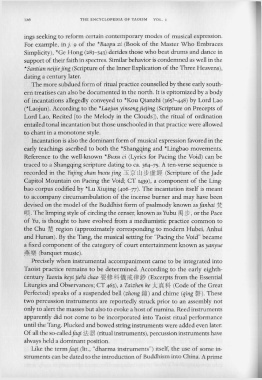Page 166 - The Encyclopedia of Taoism v1_A-L
P. 166
126 T H E ENCYCLOPED IA OF TAO ISM VOL. r
ings seeking to reform certain contemporary modes of musical expression.
For example, in j. 9 of the *Baopu zi (Book of the Master Who Embraces
Simplicity), *Ge Hong (283-343) derides those who beat drums and dance in
support of their faith in spectres. Similar behavior is condemned as well in the
*Santian neijie jing (Scripture of the Inner Explication of the Three Heavens),
dating a century later.
The more subdued form of ritual practice counselled by these early south-
ern treatises can also be documented in the north. It is epitomized by a body
of incantations allegedly conveyed to *Kou Qianzhi (365?- 448) by Lord Lao
(*Laojun). According to the *Laojun yinsongjiejing (Scripture on Precepts of
Lord Lao, Recited [to the Melody in the Clouds]), the ritual of ordination
entailed tonal incantation but those unschooled in that practice were allowed
to chant in a monotone style.
Incantation is also the dominant form of musical expression favored in the
early teachings ascribed to both the *Shangqing and *Lingbao movements.
Reference to the well-known *Buxu ci (Lyrics for Pacing the Void) can be
traced to a Shangqing scripture dating to ca. 364-75. A ten-verse sequence is
recorded in the Yujing shan buxu jing .=rr. * ill zv m. ~~ (Scripture of the Jade
Capitol Mountain on Pacing the Void; CT 1439), a component of the Ling-
bao corpus codified by *Lu Xiujing (406- 77). The incantation itself is meant
to accompany circumambulation of the incense burner and may have been
devised on the model of the Buddhist form of psalmody known as fanbai Jt
PJ;{ . The limping style of circling the censer, known as Yubu ~ ZV , or the Pace
of Yu, is thought to have evolved from a mediurnistic practice common to
the Chu ~ region (approximately corresponding to modern Hubei, Anhui
and Hunan). By the Tang, the musical setting for "Pacing the Void" became
a fixed component of the category of court entertainment known as yanyue
~~ (banquet music).
Precisely when instrumental accompaniment came to be integrated into
Taoist practice remains to be determined. According to the early eighth-
century Yaoxiu keyi jielii. chao ~{~ f4{~lttX;f=It~ (Excerpts from the Essential
Liturgies and Observances; CT 463), a Taizhen ke :t;g;f-t (Code of the Great
Perfected) speaks of a suspended bell (zhong ~) and chime (qing ~). These
two percussion in truments are reportedly struck prior to an assembly not
only to alert the masses but also to evoke a host of numina. Reed instruments
apparently did not come to be incorporated into Taoist ritual performance
until the Tang. Plucked and bowed string instruments were added even later.
Of all the so-calledfaqi "i!~ (ritual instruments), percussion instruments have
always held a dominant position.
Like the term faqi (lit., "dharma instruments") itself, the use of some in-
struments can be dated to the introduction of Buddhism into China. A prime

